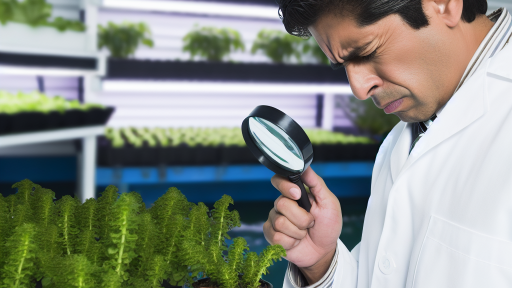Introduction to Soil Microbiology
Understanding Soil Microbiology
Soil microbiology focuses on the study of microorganisms in soil.
These microorganisms play a crucial role in soil health and fertility.
They include bacteria, fungi, protozoa, and nematodes.
Each type contributes uniquely to nutrient cycling and organic matter decomposition.
Importance in Agriculture
Soil microbiology is fundamental for sustainable agriculture.
Healthier soils lead to more productive crops.
Moreover, microorganisms assist in breaking down organic matter.
This process enriches the soil with essential nutrients.
For instance, nitrogen-fixing bacteria convert atmospheric nitrogen into a usable form for plants.
Enhancing Soil Fertility Naturally
Utilizing soil microorganisms can enhance fertility without synthetic fertilizers.
Natural amendments, such as compost, introduce beneficial microbes.
This practice boosts microbial diversity and activity in the soil.
Healthy microbial communities improve soil structure and water retention.
Microbial Interactions
Microorganisms interact with plants in beneficial ways.
Mycorrhizal fungi extend plant roots and improve nutrient uptake.
Transform Your Agribusiness
Unlock your farm's potential with expert advice tailored to your needs. Get actionable steps that drive real results.
Get StartedSome bacteria produce hormones that promote plant growth.
Additionally, these interactions can increase the resilience of crops to pests and diseases.
Challenges and Opportunities
Despite their importance, soil microbiology faces challenges.
Modern agricultural practices often harm microbial communities.
Excessive use of chemicals diminishes biodiversity in the soil.
Conversely, organic farming promotes healthy microbial ecosystems.
Thus, understanding and supporting microbial life is essential for future agriculture.
Key Microorganisms in Soil
Bacteria
Bacteria are crucial to soil fertility and health.
They decompose organic matter, releasing nutrients for plants.
Specific types of bacteria enhance nitrogen fixation.
This process improves soil protein availability.
Additionally, they help in the mineralization of nutrients.
Common genera include Rhizobium and Azotobacter.
Fungi
Fungi play a significant role in soil ecosystems.
They form symbiotic relationships with plant roots.
Mycorrhizal fungi enhance water and nutrient uptake.
This relationship benefits both the plant and the fungus.
Fungi also break down complex organic materials.
Examples include Trichoderma and Penicillium.
Protozoa
Protozoa are vital for nutrient cycling in the soil.
They feed on bacteria, releasing nutrients in the process.
These microorganisms help regulate bacterial populations.
Overall, they contribute to soil health and structure.
Common types include amoeba and flagellates.
Showcase Your Farming Business
Publish your professional farming services profile on our blog for a one-time fee of $200 and reach a dedicated audience of farmers and agribusiness owners.
Publish Your ProfileInteractions Among Microorganisms
Microorganisms interact in complex ways within the soil.
These interactions promote stability and resilience in ecosystems.
Bacteria and fungi often compete for resources.
However, they can also cooperate in nutrient cycling.
Such dynamics enhance soil fertility overall.
Importance of Soil Microorganisms
The health of soil microorganisms directly impacts agriculture.
They improve crop yields and resilience to disease.
Moreover, they enhance soil structure and aeration.
Sustaining microbial diversity is crucial for future farming.
Soil Fertility
Definition of Soil Fertility
Soil fertility refers to the ability of soil to support plant growth.
This ability is influenced by soil composition, structure, and nutrient availability.
Healthy soil contains essential nutrients for plants, such as nitrogen, phosphorus, and potassium.
Moreover, it provides a suitable environment for root development.
Soil fertility plays a crucial role in sustainable agriculture.
Understanding soil fertility is essential for maximizing crop yields.
The Role of Microorganisms in Soil Fertility
Microorganisms are vital contributors to soil fertility.
They help decompose organic matter, releasing nutrients into the soil.
Bacteria, fungi, and other microorganisms work together to form a rich ecosystem.
These microorganisms enhance nutrient cycling, making essential elements more accessible to plants.
For example, certain bacteria fix atmospheric nitrogen, converting it into a usable form.
This process enriches the soil and promotes healthy plant growth.
Furthermore, microorganisms improve soil structure by creating stable aggregates.
These aggregates enhance water retention and aeration in the soil.
Ultimately, a thriving microorganism community is crucial for maintaining soil fertility.
Factors Affecting Soil Microbial Activity
Several factors influence the activity of soil microorganisms.
Soil moisture levels significantly affect microbial populations.
Optimal moisture creates a favorable environment for microorganisms to thrive.
Additionally, soil temperature plays a critical role in microbial activity.
Higher temperatures can accelerate metabolic processes, boosting microbial growth.
Further, soil pH affects the availability of nutrients and the types of microorganisms present.
Balanced pH levels encourage a diverse and robust microbial community.
Lastly, organic matter inputs, such as compost, stimulate microbial development.
These factors interact to create a dynamic ecosystem within the soil.
Explore Further: Optimizing Light for Hydroponic Growth
Natural Methods to Enhance Soil Fertility: A Holistic Approach
Understanding Soil Microbiology
Soil microbiology plays a crucial role in maintaining soil health.
Microorganisms break down organic matter into essential nutrients.
They promote nutrient cycling and enhance soil structure.
Furthermore, they help control plant diseases naturally.
Naturally Adding Organic Matter
Incorporating organic matter boosts soil fertility significantly.
You can use compost, which enriches the soil with nutrients.
Showcase Your Farming Business
Publish your professional farming services profile on our blog for a one-time fee of $200 and reach a dedicated audience of farmers and agribusiness owners.
Publish Your ProfileGreen manures also enhance nitrogen levels in the soil.
Additionally, mulch retains moisture and suppresses weeds.
Utilizing Cover Crops
Cover crops improve soil structure and prevent erosion.
These crops capture nutrients and reduce runoff.
Leguminous cover crops fix atmospheric nitrogen.
Consequently, this enriches the soil for subsequent crops.
Implementing Crop Rotation
Crop rotation disrupts pest cycles and enhances soil fertility.
Diverse crops improve nutrient uptake and soil health.
Rotating legumes with cereals replenishes nitrogen levels sustainably.
This practice also reduces the dependency on synthetic fertilizers.
Encouraging Soil Biodiversity
Diverse soil organisms contribute to enhanced fertility.
Encouraging beneficial microbes promotes healthy soil ecosystems.
You can achieve this by minimizing chemical inputs.
Additionally, fostering a variety of plant species supports biodiversity.
Practicing Reduced Tillage
Reduced tillage practices preserve soil structure and health.
This approach minimizes soil disturbance and erosion.
Moreover, it promotes the growth of beneficial microorganisms.
Healthy soil ecosystems avert the need for excessive inputs.
Implementing Natural Amendments
Natural amendments like bone meal can enrich soil nutrients.
Fish emulsion provides a quick source of nitrogen.
Furthermore, adding rock phosphate improves phosphorus availability.
These amendments enhance soil fertility without synthetic chemicals.
Gain More Insights: Scaling Up Your Aquaponics Business
Mycorrhizal Fungi: Benefits and Applications in Crop Production
Understanding Mycorrhizal Fungi
Mycorrhizal fungi form symbiotic relationships with plant roots.
These fungi enhance nutrient uptake for their host plants.
In return, they receive carbohydrates from the plants.
Types of Mycorrhizal Fungi
Two main types exist: arbuscular mycorrhizal fungi and ectomycorrhizal fungi.
Arbuscular mycorrhizal fungi penetrate plant cells.
Ectomycorrhizal fungi wrap around root tips.
Both types improve plant health and growth.
Benefits of Mycorrhizal Fungi
Mycorrhizal fungi increase soil productivity naturally.
They enhance phosphorus and nitrogen availability to plants.
Additionally, they improve soil structure and aeration.
This leads to better water retention and drainage.
Healthy plants become more resistant to pathogens.
Applications in Crop Production
Farmers can utilize mycorrhizal fungi to enhance yields.
They can apply mycorrhizal inoculants during planting.
Moreover, cover cropping with mycorrhizal fungi can be beneficial.
Crop rotation can also enhance fungal populations in the soil.
Case Studies
A study in Iowa showed increased corn yields with mycorrhizal fungi.
Showcase Your Farming Business
Publish your professional farming services profile on our blog for a one-time fee of $200 and reach a dedicated audience of farmers and agribusiness owners.
Publish Your ProfileIn California, vineyards reported improved grape quality.
These results demonstrate the practical advantages of using mycorrhizal fungi.
Future Directions
Research continues on optimizing mycorrhizal applications.
Scientists explore their role in organic farming.
Furthermore, understanding interactions with other soil microbes is essential.
This knowledge can lead to more sustainable agricultural practices.
Find Out More: Innovative Approaches To Pest Forecasting For Farmers
Composting and its Impact on Soil Microbial Communities
Understanding Composting
Composting involves the aerobic decomposition of organic materials.
This process transforms waste into nutrient-rich soil amendments.
It enhances soil fertility and overall health.
Enhancing Soil Microbial Diversity
Composting significantly increases soil microbial diversity.
Diverse microbial communities promote greater resilience in ecosystems.
Higher microbial diversity can improve nutrient cycling and availability.
The Role of Microorganisms in Composting
Microorganisms are the primary agents of decomposition.
Bacteria and fungi play crucial roles in breaking down organic matter.
These microbes convert complex organic materials into simpler compounds.
This process enriches compost and provides essential nutrients for plants.
Effects on Soil Structure
Composting positively impacts soil structure and aeration.
It improves soil aggregation and promotes better water retention.
Healthy soil structure fosters root growth and enhances plant health.
Impact on Soil Fertility
Compost is rich in essential nutrients.
It supplies plants with nitrogen, phosphorus, and potassium.
Moreover, compost contains micronutrients that are vital for growth.
This nutrient balance supports healthy and productive crops.
Microbial Activity and Organic Matter
Composting boosts microbial activity in soil.
Active microbes decompose additional organic matter, enriching the soil.
This ongoing process contributes to sustained soil fertility over time.
Practical Applications in Agriculture
Farmers and gardeners can utilize compost to increase productivity.
Adding compost to soil enhances crop yields and reduces chemical inputs.
This practice aligns with sustainable agriculture principles.
Insights on Composting’s Role in Soil Health
The impact of composting on soil microbial communities is profound.
It enhances diversity, fertility, and microbial activity sustainably.
Composting is an effective strategy for natural soil enhancement.
Gain More Insights: How to Start an Organic Crop Farm: A Beginner’s Guide

Cover Cropping: Enhancing Soil Health and Biodiversity
Introduction to Cover Cropping
Cover cropping plays a vital role in sustainable agriculture.
It enhances soil health and promotes biodiversity.
Farmers use cover crops to protect soil during fallow periods.
Additionally, these crops improve nutrient management.
Types of Cover Crops
Various types of cover crops exist, each serving unique purposes.
- Legumes enrich the soil with nitrogen.
- Cereal grains prevent soil erosion.
- Brassicas improve soil structure and suppress weeds.
Benefits of Cover Cropping
Cover crops offer numerous benefits to agricultural ecosystems.
Showcase Your Farming Business
Publish your professional farming services profile on our blog for a one-time fee of $200 and reach a dedicated audience of farmers and agribusiness owners.
Publish Your ProfileThey enhance soil fertility through organic matter addition.
Moreover, they improve water retention in the soil.
In addition, these crops support beneficial microorganisms.
Implementing Cover Cropping
Successful implementation requires planning and management.
Farmers should select the right crop according to their climate.
They must also consider the crop rotation for maximal benefits.
Regular monitoring ensures the cover crops perform effectively.
Case Studies of Successful Cover Cropping
Many farms demonstrate the effectiveness of cover cropping.
The Green Valley Farm uses clover effectively to enrich soil.
They noticed improved yields and reduced fertilizer costs.
Similarly, Maple Grove Farm successfully employs rye as a cover crop.
They report better moisture retention and lower erosion rates.
Challenges and Considerations
While beneficial, cover cropping has challenges.
Farmers may face issues with plant selection and management.
Weather conditions also impact the effectiveness of cover crops.
Therefore, continuous education and adaptation are crucial.
Identifying Soil Health: Indicators and Testing Methods
Understanding Soil Health
Soil health is crucial for sustainable agriculture.
It affects plant growth, water retention, and nutrient cycling.
Healthy soil promotes beneficial microorganisms and enhances fertility.
Key Indicators of Soil Health
Several indicators help assess soil health.
- Soil texture influences aeration and water retention.
- pH levels determine nutrient availability.
- Organic matter content indicates soil fertility levels.
- Bacterial and fungal biomass reflect biological activity.
Soil Testing Methods
Testing soil health involves various methods.
Laboratory analysis offers precise nutrient profiles.
Home tests can provide general indicators of soil condition.
Common Soil Testing Kits
Several kits are available for home soil testing.
- pH test kits measure acidity or alkalinity.
- Nutrient test kits analyze macro and micronutrients.
- Moisture meter tests determine soil hydration levels.
Interpreting Soil Test Results
Understanding results is vital for effective management.
Compare results with recommended values for crops.
Identify deficiencies and plan amendments accordingly.
Additional Methods to Assess Soil Health
Field observations also provide insight into soil health.
Look for signs of erosion, compaction, and plant health.
Consider earthworm activity as an indicator of soil vitality.
Future Directions: Innovations in Soil Microbiology and Sustainable Farming
Emerging Technologies in Soil Analysis
Technological advancements transform soil analysis methods significantly.
Novel sensors allow for real-time monitoring of soil health.
Furthermore, drone technology aids in mapping soil properties efficiently.
Microbial Enhancements for Crop Production
Innovative microbial solutions improve soil fertility naturally.
These solutions enhance nutrient uptake in crops effectively.
They also promote plant resilience against pests and diseases.
Integrating Traditional and Modern Practices
Combining traditional farming techniques with modern research offers advantages.
Farmers can adopt traditional crop rotation methods effectively.
These practices are enhanced by modern microbiological knowledge.
Collaboration Among Stakeholders
Collaboration between farmers, scientists, and policymakers is essential.
Showcase Your Farming Business
Publish your professional farming services profile on our blog for a one-time fee of $200 and reach a dedicated audience of farmers and agribusiness owners.
Publish Your ProfilePartnerships drive innovation and knowledge sharing in agriculture.
Moreover, community engagement encourages sustainable practices.
The Role of Education and Awareness
Education plays a vital role in advancing sustainable farming.
Awareness programs inform farmers about soil microbiology benefits.
Training sessions empower them to utilize new practices effectively.
Additional Resources
Microbiome as a Key Player in Sustainable Agriculture … – Frontiers




